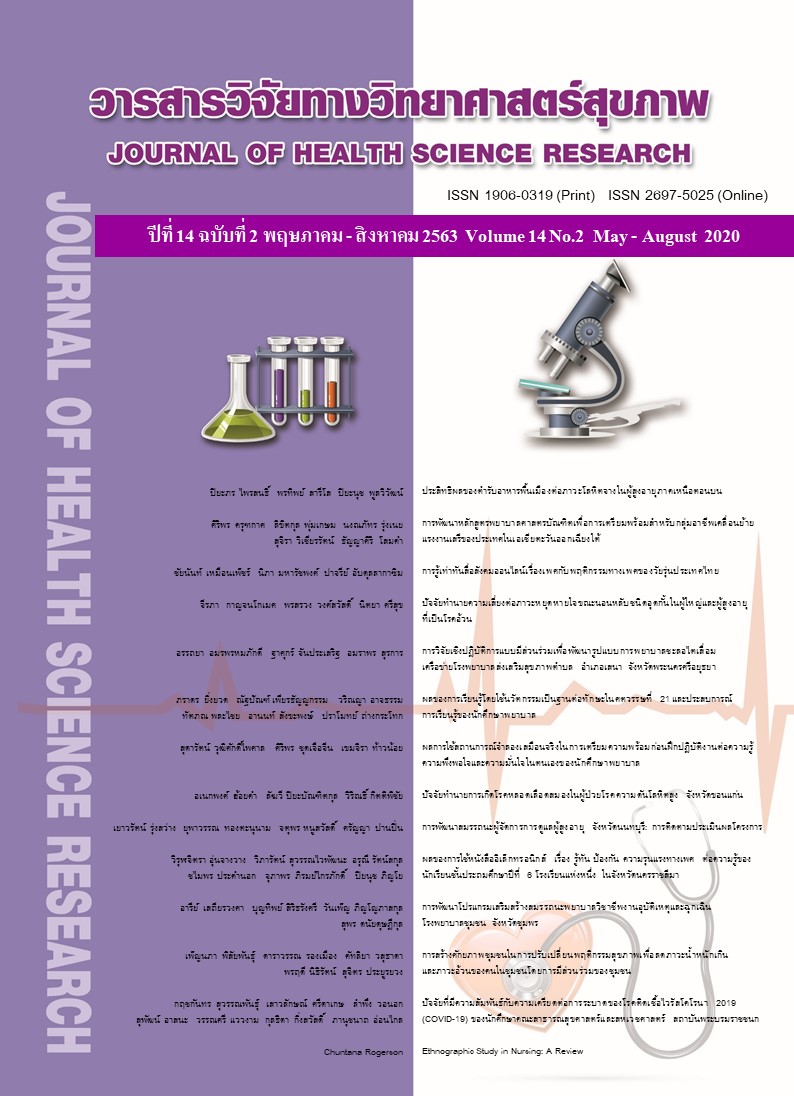การรู้เท่าทันสื่อสังคมออนไลน์เรื่องเพศกับพฤติกรรมทางเพศ ของวัยรุ่นประเทศไทย
Main Article Content
บทคัดย่อ
บทนำ: วัยรุ่นไทยมีแนวโน้มพฤติกรรมเสี่ยงทางเพศเพิ่มสูงขึ้น ซึ่งการรู้เท่าทันสื่อสังคมออนไลน์เรื่องเพศเป็นปัจจัยสำคัญที่มีผลต่อพฤติกรรมทางเพศของวัยรุ่น
วัตถุประสงค์การวิจัย: เพื่อศึกษาการรู้เท่าทันสื่อสังคมออนไลน์เรื่องเพศ และปัจจัยที่มีความสัมพันธ์กับพฤติกรรมทางเพศของวัยรุ่นประเทศไทย
วิธีการวิจัย: การวิจัยพรรณนาภาคตัดขวาง กลุ่มตัวอย่าง คือ วัยรุ่นที่ศึกษาปริญญาตรีในสถาบันอุดมศึกษา จำนวน 1,321 คน เก็บข้อมูลโดยใช้แบบสอบถามออนไลน์ วิเคราะห์ข้อมูลโดยใช้สถิติพรรณนา วิเคราะห์หาความสัมพันธ์โดยใช้สถิติไคสแควร์ หาขนาดความสัมพันธ์ด้วยสถิติโลจิสติกทวิ และหาโอกาสที่จะเกิดเหตุการณ์ใช้ค่า Adjusted Odds Ratio ที่ความเชื่อมั่นร้อยละ 95
ผลการวิจัย: วัยรุ่นมีการรู้เท่าทันสื่อสังคมออนไลน์เรื่องเพศระดับสูง ร้อยละ 56.10 และมีพฤติกรรมทางเพศเหมาะสม ร้อยละ 51.00 ปัจจัยที่สัมพันธ์กับพฤติกรรมทางเพศของวัยรุ่น อย่างมีนัยสำคัญทางสถิติที่ .05 ได้แก่ เพศ การเข้าถึงสื่อสังคมออนไลน์ ประสบการณ์มีเพศสัมพันธ์ การรู้เท่าทันสื่อสังคมออนไลน์เรื่องเพศ (adjusted odds ratio [AOR]=2.10, 95%CI=1.64-2.57) การสร้างสรรค์สื่อ (AOR=1.96, 95%CI=1.56-2.47) การวิเคราะห์สื่อ (AOR=1.63, 95%CI=1.22-1.96) และการประเมินค่าสื่อ (AOR=1.48, 95%CI=1.20-1.85)
สรุปผล: ผลการศึกษาพบว่าวัยรุ่นที่รู้เท่าทันสื่อสังคมออนไลน์เรื่องเพศระดับต่ำ มีโอกาสแสดงพฤติกรรมทางเพศที่ไม่เหมาะสมมากกว่าวัยรุ่นที่รู้เท่าทันสื่อระดับสูง ดังนั้น ควรส่งเสริมให้มีกิจกรรมพัฒนาทักษะ การรู้เท่าทันสื่อสังคมออนไลน์เรื่องเพศเพื่อให้เกิดพฤติกรรมทางเพศที่พึงประสงค์
Downloads
Article Details
บทความที่ได้รับการตีพิมพ์เป็นลิขสิทธิ์ของวิทยาลัยพยาบาลบรมราชชนนี จังหวัดนนทบุรี
ข้อความที่ปรากฏในบทความแต่ละเรื่องในวารสารวิชาการเล่มนี้เป็นความคิดเห็นส่วนตัวของผู้เขียนแต่ละท่านไม่เกี่ยวข้องกับวิทยาลัยพยาบาลบรมราชชนนี จังหวัดนนทบุรี และคณาจารย์ท่านอื่น ในวิทยาลัยฯ แต่อย่างใด ความรับผิดชอบองค์ประกอบทั้งหมดของบทความแต่ละเรื่องเป็นของผู้เขียนแต่ละท่าน หากมีความผิดพลาดใด ๆ ผู้เขียนแต่ละท่านจะรับผิดชอบบทความของตนเองแต่ผู้เดียว
เอกสารอ้างอิง
Dechasetsiri P. Learning achievement through electronic online lessons on the subject of leadership and contemporary management. The Golden Teak: Humanity and Social Science Journal. 2016;22(4):114-23. (in Thai).
Williamson A. Social Media Guidelines for Parliaments [Internet]. 2013 [cited 2020 Feb 2]; Available form: http:// archive.ipu.org/PDF/publications/SMG2013EN.pdf
Vichitrboonyaruk P. Social media: Future media. Executive Journal. 2011;31(4): 99-103. (in Thai).
National Statistical Office, Ministry of Digital Economy and Society. The 2018 household survey on the use of information and communication technology (quarter 4). Bangkok: National Statistical Office, Ministry of Digital Economy and Society; 2018. (in Thai).
NIDA Poll. Social media and the future of Thai youth [Internet]. 2017 [cited 2020 Feb 2]; Available form:http://nidapoll. .nida.ac.th/file_upload/poll/document/20170331025107.pdf. (in Thai).
Bergsma LJ, Carney ME. Effectiveness of health promoting media literacy education: a systematic review. Health Educ Res. 2008;23(3):522-42.
Brown JD, Witherspoon EM. The mass media and American adolescents’ health. J Adolesc Health. 2002;31(6): 153-70.
Roemsri J, Thularate N. The impact of social media use among adolescent. Journal of Suvarnabhumi Institute of Technology (Humanities and Social Sciences). 2018;3(1):11-20. (in Thai).
Buarod T, Thongnopakun S. Sexual media literacy and preventive behaviors about sexually transmitted diseases among youth in university students Chon Buri Province, Thailand. Disease Control Journal. 2019;45(4):402-12. (in Thai).
Pounglek W. Internet Pornography: Risk caution and Prevention guideline against its effects on Thai youth. Executive Journal. 2011;31(2):223-33. (in Thai).
Tansuwannond C, Wongpinpech P, Leesattrupa C. Factors related to intellectual media consumption behavior of undergraduate students in Bangkok. Journal of Behavioral Science. 2010; 16(1):122-35. (in Thai).
World Health Organization. Thailand 2015 global school-based student health survey. Bangkok: World Health Organization, Thailand Country Office; 2017.
Bureau of Epidemiology, Department of Disease Control, Ministry of Public Health. National disease surveillance (Report 506), 2008–2015. Nonthaburi: Bureau of Epidemiology; 2015. (in Thai).
United Nations Educational, Scientific and Cultural Organization. Media and information literacy: policy and strategy guidelines. France: United Nations Educational, Scientific and Cultural Organization; 2013.
Cochran WG. Sampling Techniques. 3rd edition. New York: John Wiley & Sons; 1997.
Thongnopakun S, Maharachpong N, Abdullakasim P. Factors related to the sexual behaviors among youth in Universities location in Eastern Region of Thailand. Journal of Medical Association of Thailand. 2016;99(1):43-50. (in Thai)
Clark-Carter D. Percentiles. In: Everitt BS, Howell D, editors. Encyclopedia of Statistics in Behavioral Science. 3th ed. Hoboken, NJ: Wiley; 2005. p.1539-40.
Wiboonphan S. Association between social media literacy and sexual behaviors of adolescent in Banglamung District, Chonburi Province. [Thesis]. Chonburi: Burapha University; 2017.104 p. (in Thai).
Wiwatpanitch N. A development of social media literacy skills. Journal of Graduate Studies, Valaya Alongkorn Rajabhat. 2015;9(3):209-19. (in Thai).
Nunta S. Media used situation and development of media literacy process for Surin youth. University of the Thai Chamber Commerce Journal. 2019;39 (2):52-67. (in Thai).
Pinkleton BE, Austin EW, Chen YC, Cohen M. The role of media literacy in shaping adolescents' understanding of and responses to sexual portrayals in mass media. J Health Commu. 2012;17 (4):460-76.
Prasitwisate G. Media literacy, self-awareness and information exposure behavior on social media of University students. Journal of Humanities and Social Sciences, Mahasarakham University. 2019;37(1):200-13. (in Thai).
Buckingham D. Children and new media. In: Lievrouw LA, Livingstone S, editors. The handbook of new media: Updated student edition, London: Sage; 2006. p.75-91.


